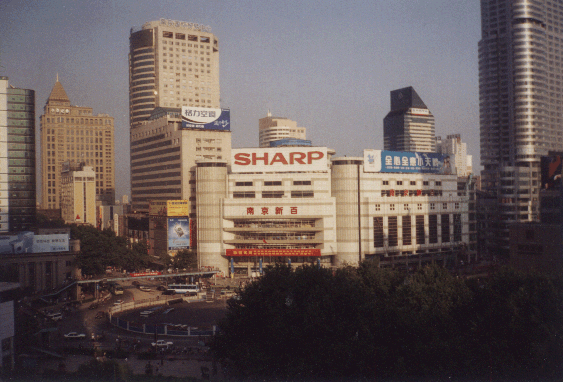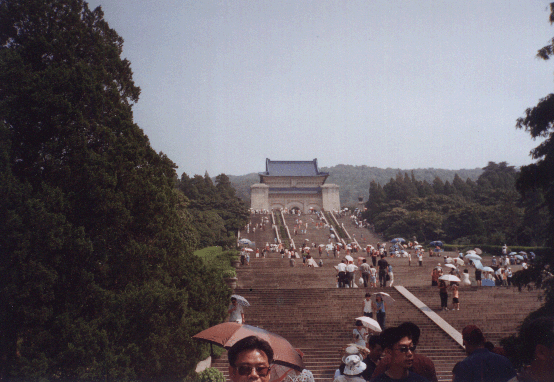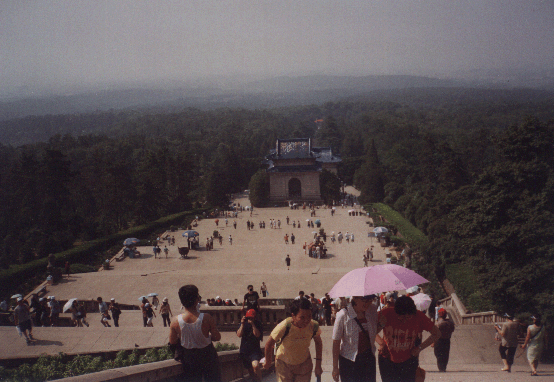 |
My job brought me a second time to China in July 2002. After visiting Shanghai last year I could visit Nanjing now.
Nanjing is located around 300 km northwest of Shanghai and has a population of approx. 4 million inhabitants. The more than 2,700 years old capital of the Jiangsu province has been developed at very high speed as are almost all cities in China. The modern Nanjing introduces itself with high buildings, department stores, Boutiques of well-known couturiers, and a sub-way is currently under construction.
The traffic in Nanjing outshines the traffic in many towns of our western world. The most popular car is the VW Santana. The Santana serves mostly as a taxi. Volkswagen produces this car in China but also other manufacturers such as the Japanese and Americans are trying to conquer the Chinese car market. |
A landmark of the modern age in Nanjing is the two-level Yangzi bridge built in 1968. The Yangzi river is 1.5 km wide and 21 m deep at this point. The whole bridge together with the approach-ramps is 6772 m long. A truly impressive construction.
In spite of the fast development of the city it is possible to find a lot of the old China. Nanjing is still almost completely surrounded by a city wall which were built in the 3rd century.
Nanjing (Southern Capital), in the past also called Nanking (Heavenly Capital), was several times the capital of the Chinese empire and later the capital of the 1st. Republic (proclaimed in 1912) and also the residence of the Guomindang regime of Tschiang Kaischek between 1927 and 1938.
The first emperors of the Ming era lived here and found their eternal rest in the Zijin mountains.
The ruins of the palace, parts of which are now changed into a park, are located in the east of the city. |
 | Another impressive place is the mauseleum of Dr. Sun Yatsen. Dr. Sun is the founder of the 1st Chinese Republic and was buried first in Beijing and found his last eternal rest in Nanjing in 1927. The tomb is located under the large memorial hall and can be reached only by foot via a 375 m long paved pathway and 392 steps. |
The gate in the middle of the pathway carries one of Dr. Sun most cited sayings "The world belongs to everybody" (Tian Xia Wei Gong). |  |
The Chinese people shouldn't go unmentioned. Western people will be surprised over and over again by the openness and kindness of the Chinese. Many people stopped me on the street and asked me for my nationality and for my reasons to be in China. Sometimes a pleasant conversation developed between two complete strange people. A smile will be answered with a smile. Exemplary? Certainly. |
My colleague Mr. Bernd Praetzler with
"our child prodigy". |
The young and youngest Chinese also surprised me. The Chinese government is trying to bring the education in schools and also in kindergartens to a higher level. Thoughts about the introduction of the German dual educational system is an example of this. The English language has been taught in a playful way in kindergartens for quite a few years. I met some 10 years old girls who spoke an incomparably clear and extensive English. Their themes of conversation had hardly simple. Try it with literature. They can keep up with it. The "Pisa Study" sends greetings. |
I want to thank my Chinese friends for the very interesting 3 weeks they had prepared for me. |
From left: Ms. Qiao Miao, Prof. Feng, me, Mr. Pan.
Temperatures around 40° C and a high humidity
left their marks on us.
|
|
 Nanjing, China
Nanjing, China 
 Nanjing, China
Nanjing, China 